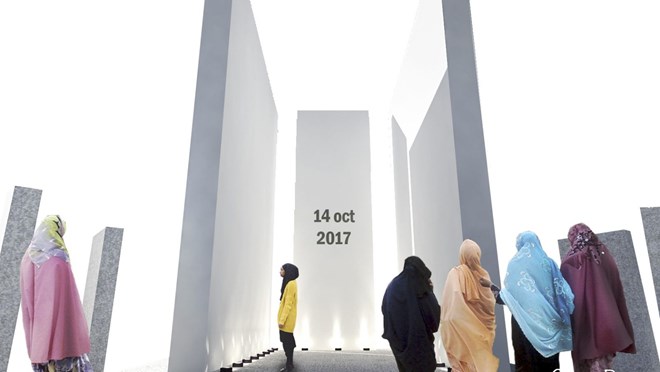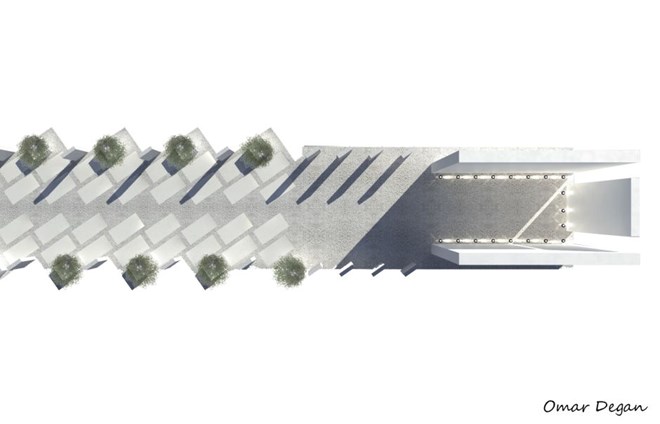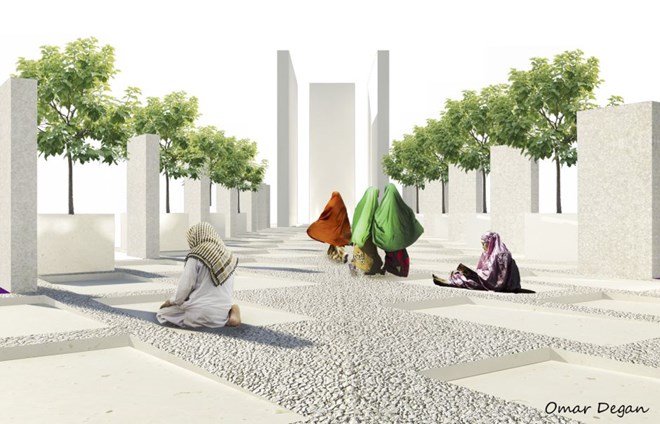
Monday December 18, 2017
By Abdi Latif Dahir

Remember those we lost. (Courtesy/Omar Degan)
It’s been two months since a deadly blast ripped through a busy intersection in the Somali capital of Mogadishu, killing more than 500 people and injuring over 300. The Oct. 14 truck bombing, the deadliest attack in Somalia’s history, turned buildings into heaps of debris and death, and left Somalis across the world stunned and frustrated.
The country is now considering dedicating its first memorial since the start of the Somali civil war in 1991 to the victims of the bombing. Italian-born Somali architect Omar Degan’s proposed design imagines an open, gravel-filled space marked with large rectangular shapes representing each victim. Surrounded by plants and blocks of concrete, the central feature of the landmark would be two walls inscribed with the names of the 512 people who died. A third wall in the middle would detail what transpired on the day of the attack.
Degan, 27, specializes in emergency architecture, which deals with rebuilding communities affected by disasters, conflict, and poverty. He thought about designing a memorial immediately after the attack. At the time, he was in Nairobi and about to embark on his first trip back to Somalia since his parents left the country.
In a country where deadly terrorist attacks are the norm, talking about the trauma of war or the unseen wounds of violence has often proven difficult. Despite the fact that Somalia’s gruesome war, which only ended in 2011, has shaped the country, there is nothing that pays homage to the war’s victims. And most of the monuments erected by the former dictator Siad Barre’s government in the 1970s and 1980s have been stolen or destroyed, while only a few, like the Tomb of the Unknown Soldier, have been renovated.
Degan wanted to do something that would make Somalis reflect. “We have enough of these tragedies but at the same time, we need to remember this event strongly and go forward,” Degan told Quartz. The memorial, he added, “obliges the visitors to walk and feel the pain somehow.”
Aerial view of the rendition of Oct. 14 Memorial Park

Aerial view of the rendition of Oct. 14 memorial site (Courtesy/Omar Degan)
Degan’s vision of the site, which he has called “Oct. 14,” is rooted in the semblance of peace that has enveloped Somalia in recent years. As open fighting has subsided, Somalis in the diaspora are coming back, establishing businesses and taking part in major development projects. After the Oct. 14 attacks, the country’s nascent tech sector stepped in to help with the search efforts and crowdfund tens of thousands of dollars to aid the families of the injured and dead.
During a recent visit, Degan said he saw a country still recovering from the effects of war with checkpoints manned by distressed officers. He speaks with enthusiasm of its picturesque Lido beach and the determination of people to change the country for the better.
Degan says officials from the Benadir Regional Administration that oversees Mogadishu approached him after seeing his design and are reviewing his sketches. He also posted the renditions of the memorial on social media in order to gauge public interest and see if people would be interested in a fundraising campaign. “We deserve better. We deserve good things in Somalia,” he said.

The architect Omar Degan hopes the landmark would spark conversations about issues affecting Somalia and Somalis. (Courtesy/Omar Degan)